COMP4350/8350
Sound and Music Computing
Envelopes, Notes and Compositions
Dr Charles Martin
So far:
- making sound from nothing (synthesis)
- making sound from recordings (sampling)
Is this enough?
Organising Sound
we now turn our attention to making “music”, not just “sound”
in this class, we’re open in terms of defining “music”, it doesn’t have to follow a particular style or emphasise traditional aspects such as melody and harmony.
broadly, we follow Edgard Varese’s idea of music as “organised sound”.
today we look at methods for organising sound in time, allowing us to start to define compositions
Shaping a note
What defines a “note”? A beginning, an end, and a shape over time.

The shape can be made by changing amplitude, but in computer music we can adjust other properties as well.
Slope is the key
/ + \
In programming we are used to having static variables
Now we want dynamic numbers that are scheduled to change in specific ways.
shapes over time
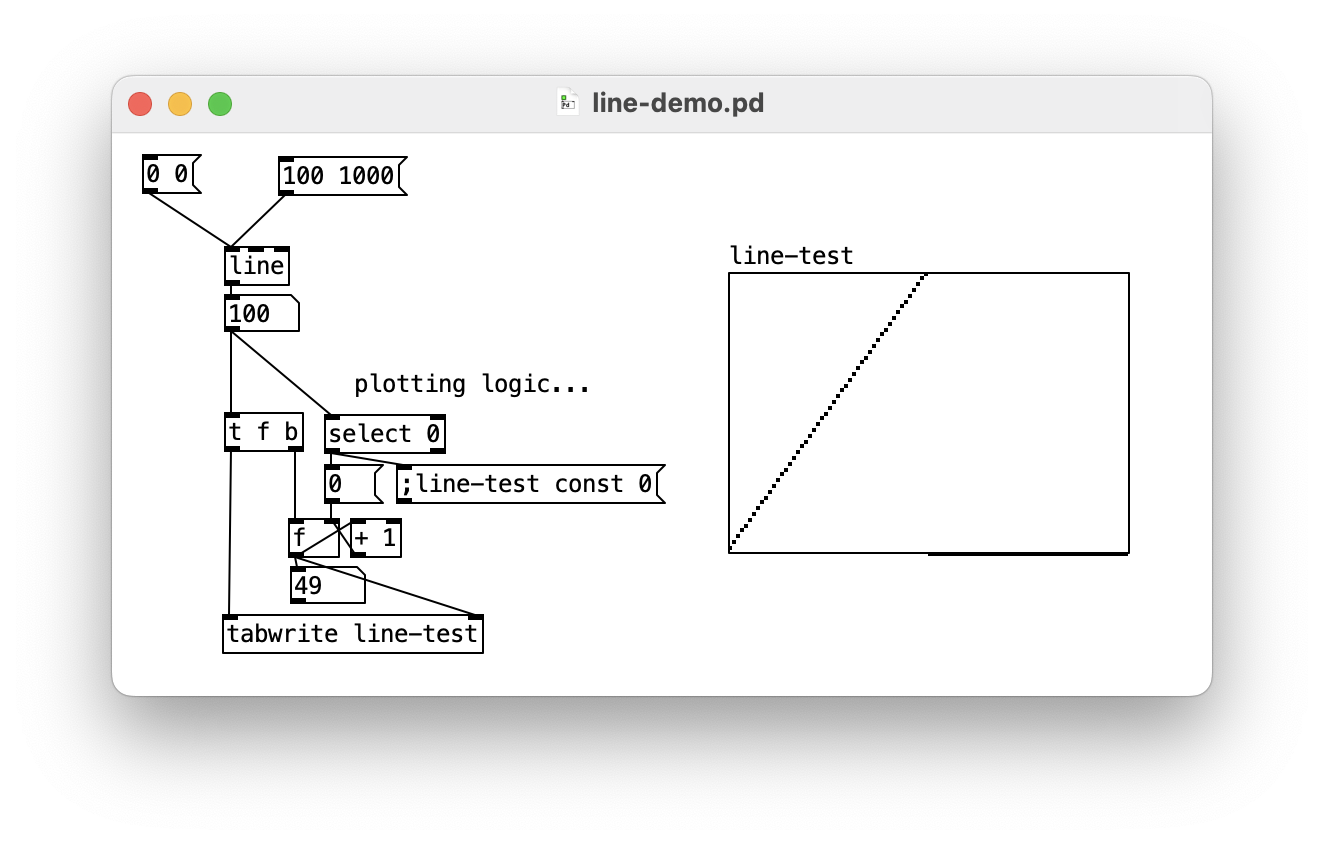
line, line~, and vline~
-
lineis a slope generator - You provide it with a destination (a number) and a time (in ms) and it changes it’s output over time.
What does the tilde mean in line~ vs line?
Pd has two kinds of “connections” between objects:
- audio
- messages
Audio connections are processed at the audio frame rate: fast enough to get blocks of 64 samples to the DAC at 44.1kHz.
Message processing is interleaved with block processing which usually happens every 1.45ms.
Objects with a ~ in the title, output or operate with audio connections. Those without ~ are the message variants.
Message boxes vs Object boxes
We’re starting to get serious with our Pd programming so make sure you understand the difference!
-
object boxes (rectangular) set out different Pd objects. First word is the object, other words are creation arguments.
-
message boxes (rectangular with a triangle cutout on the right side) define a message to be sent (the text in the box) when the box is activated by a mouse click or an incoming bang.
Messages boxes are actually programmable: they can receive arguments and incorporate them into the message string ( $1, $2…), you can set them with messages starting with set. Read the help patch for a message box to see some examples.
line and line~

-
line: outputs numbers as messages at a (default) rate of one ever 20ms (slow!) -
line~: outputs an audio rate signal.
If you make a volume control with line you will have audible clicks as the volume changes 50 times per second. You need to use line~ for smooth sounding control over audio.
An envelope has more than one slope!
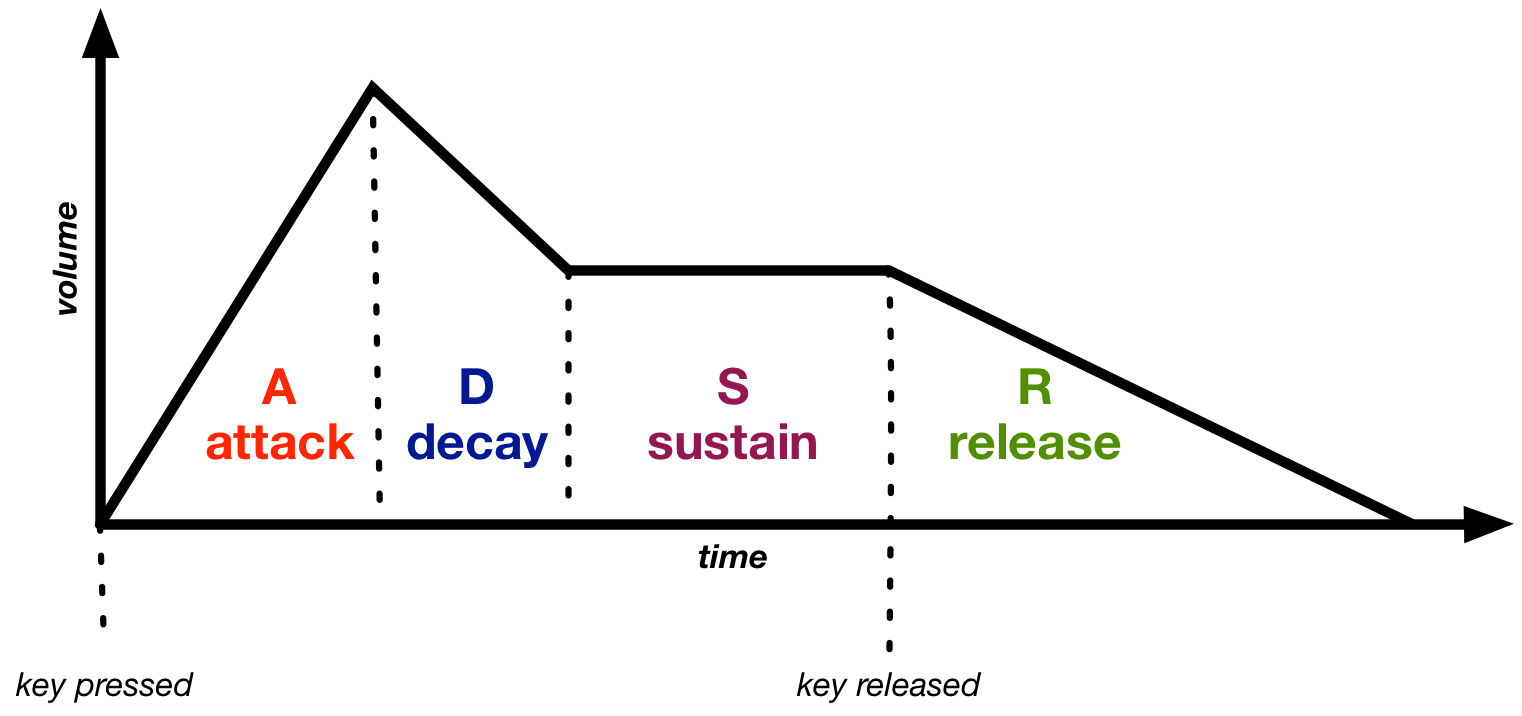
Note envelopes typically have:
- A: an attack phase (ramp up)
- R: a release phase (ramp down)
You can add some extra phases:
- D: decay (ramp down a bit just after attack)
- S: sustain (don’t ramp for the note duration)
You could call the whole thing an “ADSR” envelope.
vline~: deluxe line~
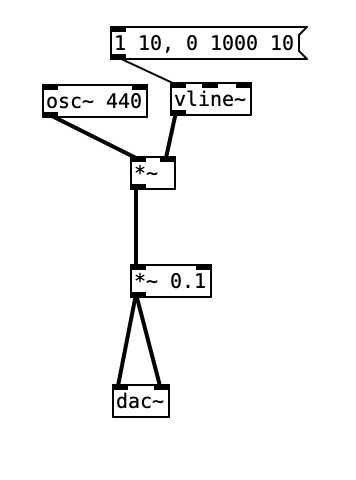
vline~ can be programmed with a comma-separated sequence of ramps of the form value ramp-time initial-delay
- this lets you schedule all the phases of an envelope in one message
-
0 1000 10means “ramp to 0 over 1000ms after 10ms” - the ramp starts from wherever it was previously
- note that all the ramps are scheduled from the starting point
- you should combine
vline~with*~to turn the sound up and down to shape a note.
vline envelope
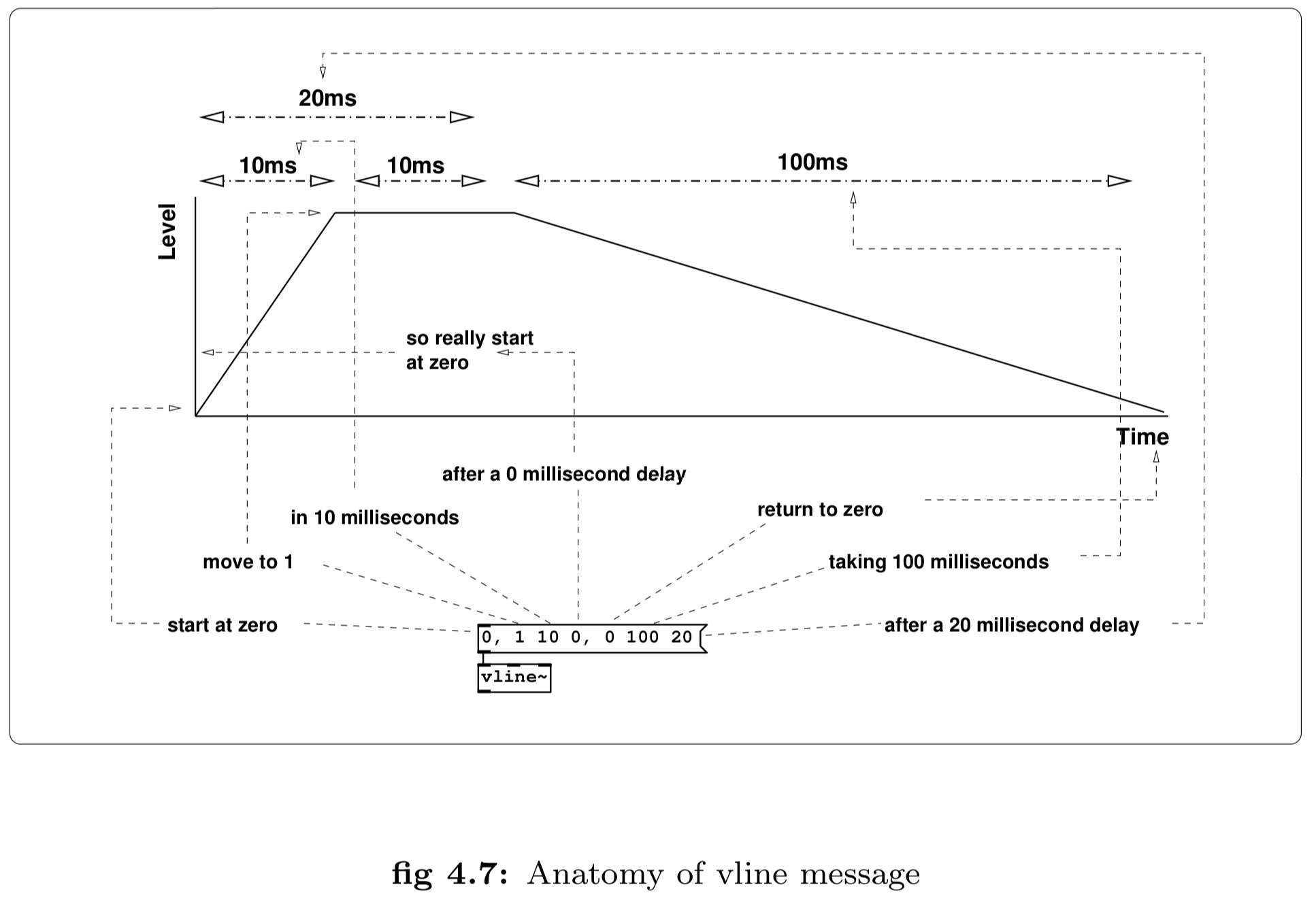
Source: Puckette, M. Theory and Technique of Electronic Music (2007).
Try it:
Create an envelope generator with
vline~in Pd with a sound source you have already created.
Make sure you know how to use get help about an object by right-clicking (or control-click).
You might want to try the metro object to generate a sequence of “bangs” to
keep triggering your envelope generator.
Sequencing
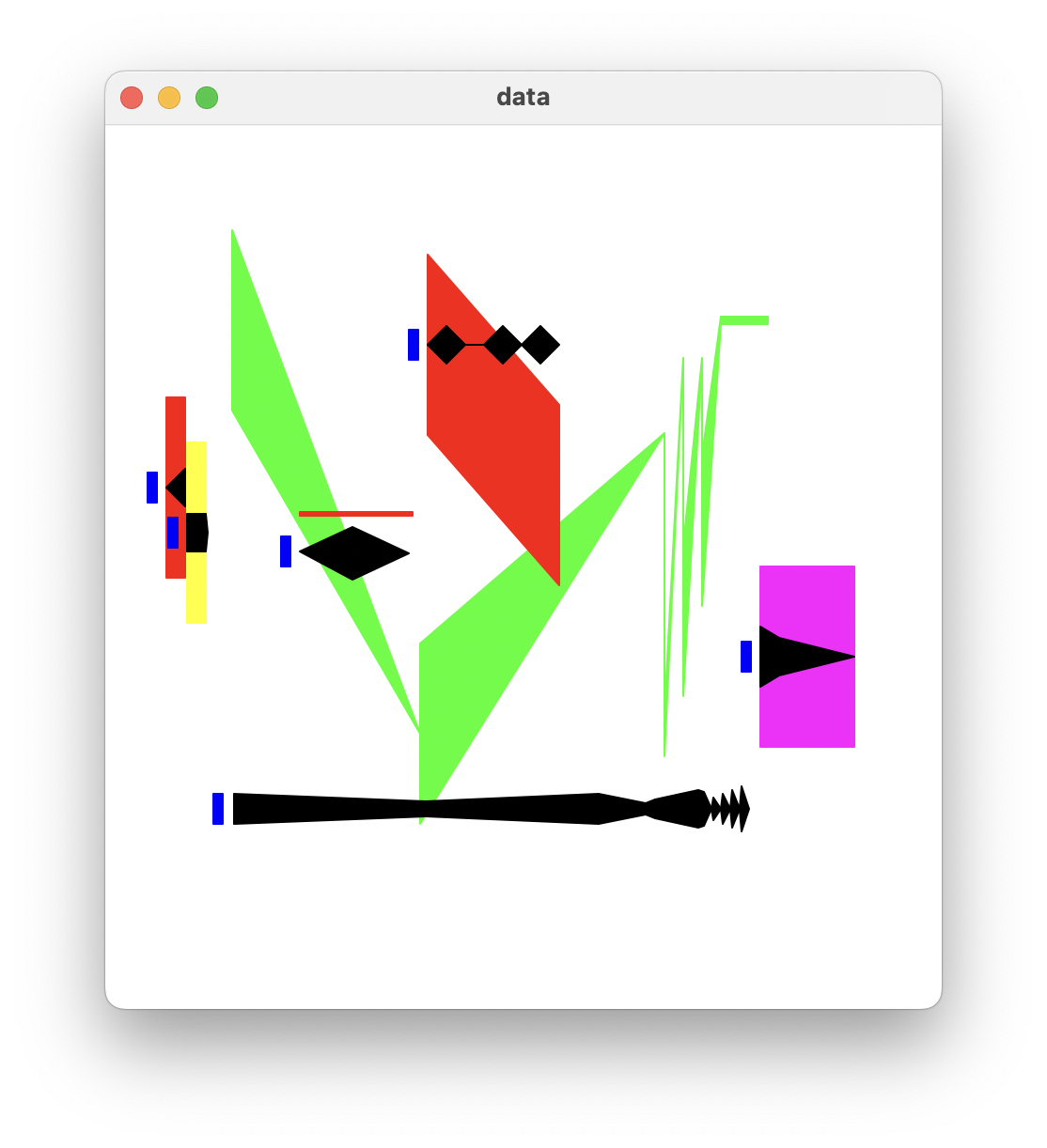
Sequencing in electronic music means scheduling events (e.g., notes) to happen in the future.
A composition represented in music notation (sheet music) is like a schedule for a musician showing them which note to play, and when in time.
In Pd, there are lots of ways to represent scheduling information (arrays, text files, long message boxes).
If you were patient enough you can use the tools you have already to organise a whole composition, just like Poeme Electronique
delay and metro

-
delayis an object that repeats whatever message it receives after a certain number of milliseconds.
N.B., delay is not an audio delay, these work differently.
-
metroemits a bang regularly after a certain number of milliseconds.
N.B., you have to start a metro by sending it a 1 or connecting it to a toggle box.
Step Sequencers
One style of sequencer divides time into a number of equal divisions or steps (e.g., 16) with zero or more musical events occurring at each step.
The sequence then repeats over and over again.
This is how most drum machines work; it’s a convenient way to make loop-based music.
Photo by Cone Trees on Unsplash
Counters and Select
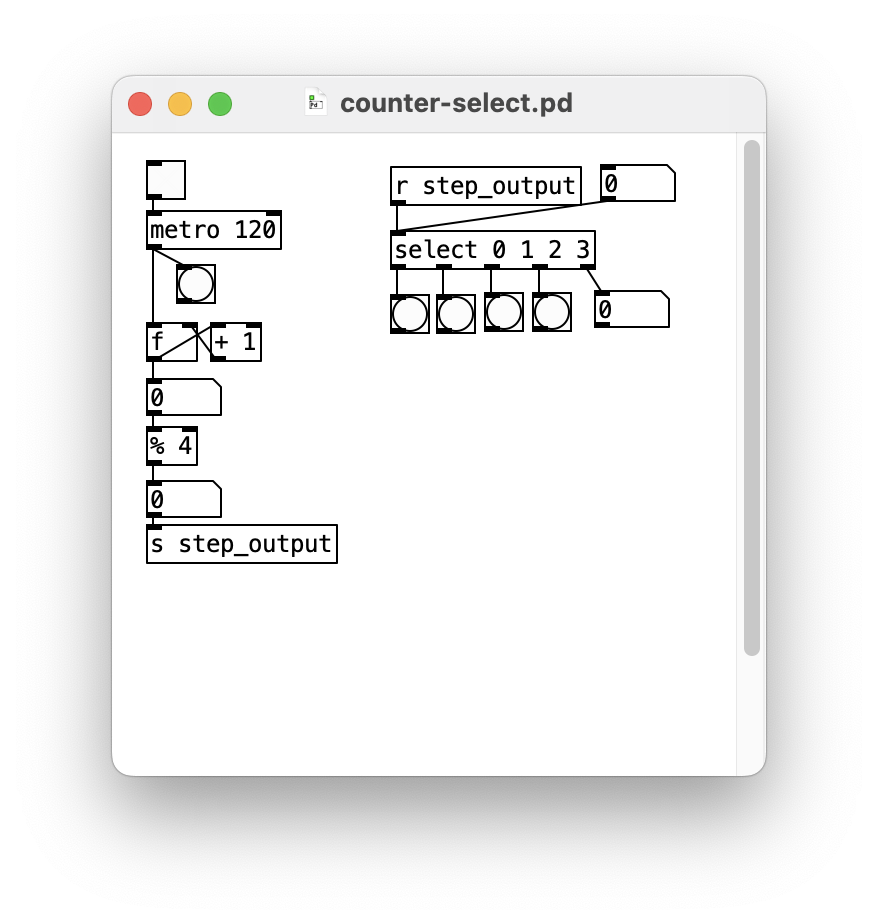
- We need a counter to make a step sequencer
- You can make one in pd with
metro,f(a nameless float variable) and+ 1 - The trick: the right inlet of
fsets its value but doesn’t send anything to the output. - The left inlet of
fcan receive a bang to spiit out the output. -
selectlets us route different actions based on a number (likeswitchin many programming languages)
(one more trick here: s and r)
A basic step sequencer

What’s new here?
-
spigot, only passes messages if right inlet is set to 1 - set “send” symbol in properties of buttons
- use subpatch (
pd ...) to hide counter logic - basic bass drum synth (AR envelope controls frequency and amplitude of an
osc~)
Even better: hide drum synth in sub-patch, use graph-on-parent to hide sequencer logic except for toggle boxes.
Modulation
-
idea: change the parameter of a ugen in time
-
usually modulation means to change it “regularly”, not every now and then like an envelope
-
we can do this by running the output of a ugen into a different ugen.
Modulation Effects: Vibrato and Tremolo
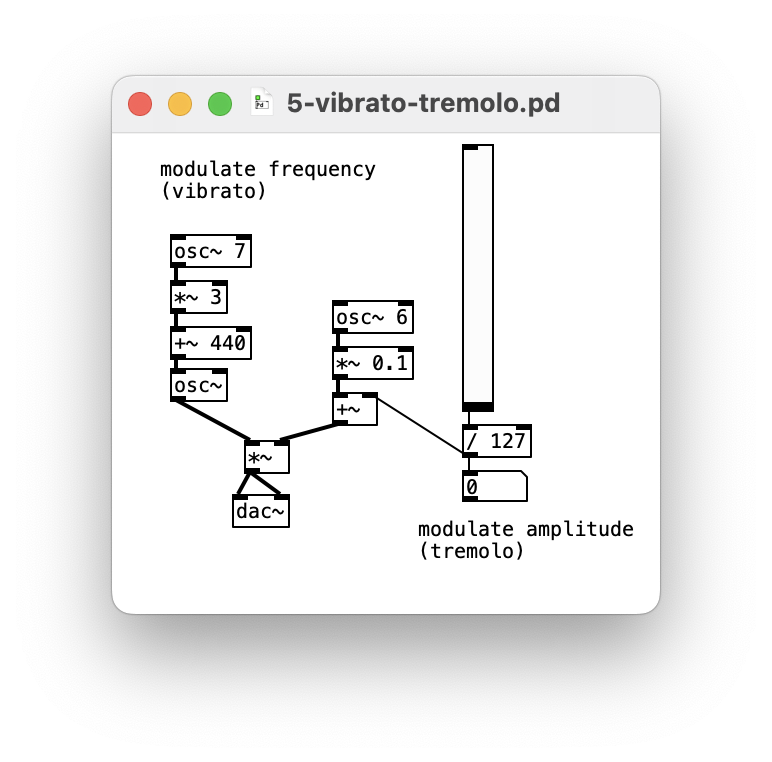
Let’s make some digital effects, vibrato and tremolo.
-
Connect a (slow)
osc~to the input of anotherosc~, need to do some maths to convert the output range (-1, 1) to something useful (e.g., 437-443) -
Connect a (slow)
osc~to the volume control, similarly change the output range. -
You could call the “sounding” osc the carrier and the not-sounding osc the modulation oscillator.
Modulation Synthesis
What if the “vibrato” was really fast? Like in the audio range?
We actually end up changing the timbre of the sound.
You can think of it as modifying the frequency domain.
We can use this to make interesting sounds without lots of oscillators for additive synthesis.
Amplitude Modulation: AM Synthesis
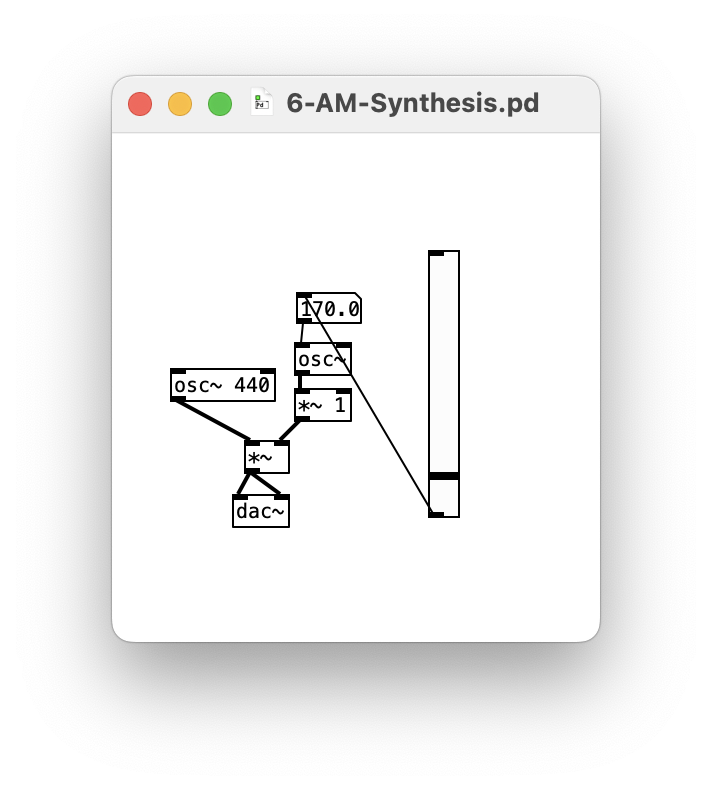
AM synthesis results in two tones.
The original spectrum is shifted up and down by the modulation frequency.
This is called “ring modulation” and the metallic sound is quite striking.
Frequency Modulation: FM Synthesis
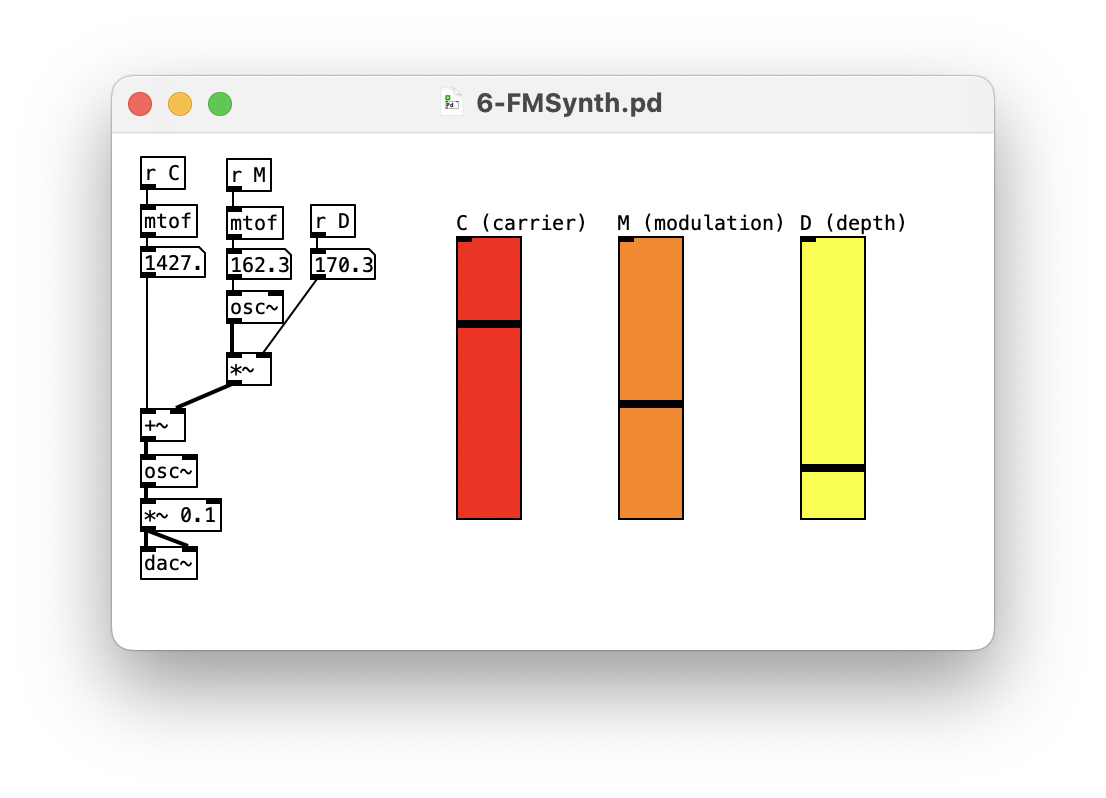
-
Three parameters: C the carrier frequency, M the modulation frequency and D the depth of modulation.
-
FM Synthesis results in extra frequencies appearing above and below the carrier frequency at multiples of the modulation frequency.
-
All three sliders change the timbre. (could be bad - why?)
Better FM Synthesis
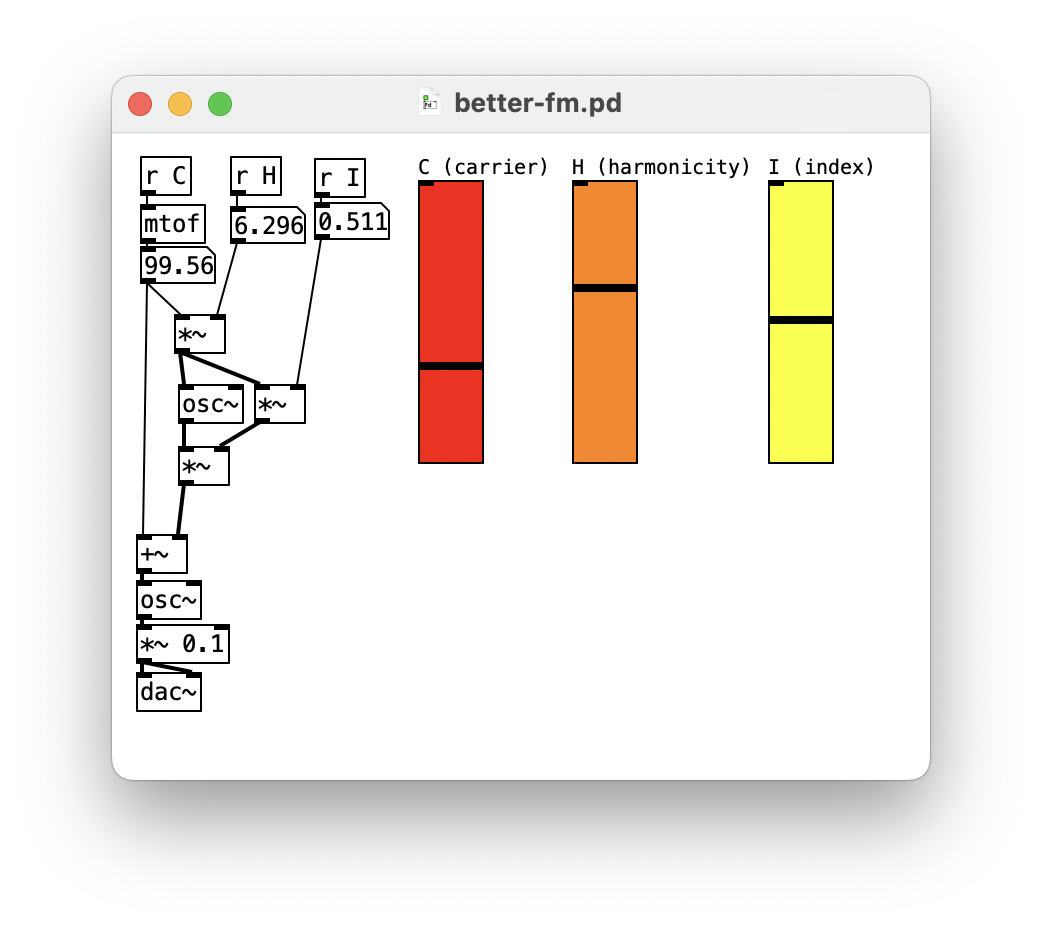
Better to have timbre separate from (fundamental) pitch. We want the shape of the spectrum to stay the same as we change carrier frequency.
-
In practice, define harmonicity $H = M/C$ and index $I = D/M$
-
If $H$ is rational, tend to get harmonic sounds ($H = 2$ has odd harmonics and sounds kindof like a clarinet)
-
If $H$ is irrational, we get dense inharmonic spectra, good for gongs or sound effects.
Phase Modulation

In practice, many “FM” algorithms actually use phase modulation
Note in the patch that the carrier oscillator is split up into a phasor~ and cos~ operator.
…it boils down to the same effect.
PM implementation works better in a multiple-operator context, e.g., Yamaha DX7 and Korg Volca FM have 6-oscillators that can be interconnected in different ways (why?)
Effects
We have timbre and notes, but what else can we use?
Synths can sound better with a bit of processing of the output sound.
We can emulate an acoustic space (smooth out the sound), get the sound a bit dirty with distortion/clipping, or modify the amplitude to help mix things together.
Delay (the audio kind)

To delay some audio means to hold it back from playing for a certain amount of time.
-
delwrite~: define a delay line (length in milliseconds), and send audio into it -
delread~: get audio out of the delay line at any point.
imagine rolling marbles down a pipe and cutting a hole in it to access ones you rolled down previously… (kind of).
Delay Effect Parameters

typical “delay” effects probably have controls for:
- effect volume
- feedback
- delay time
sometimes we call the non-effected sound dry and the effected sound wet
Let’s go do it: make a delay effect with GUI objects for these four parameters.
Reverb
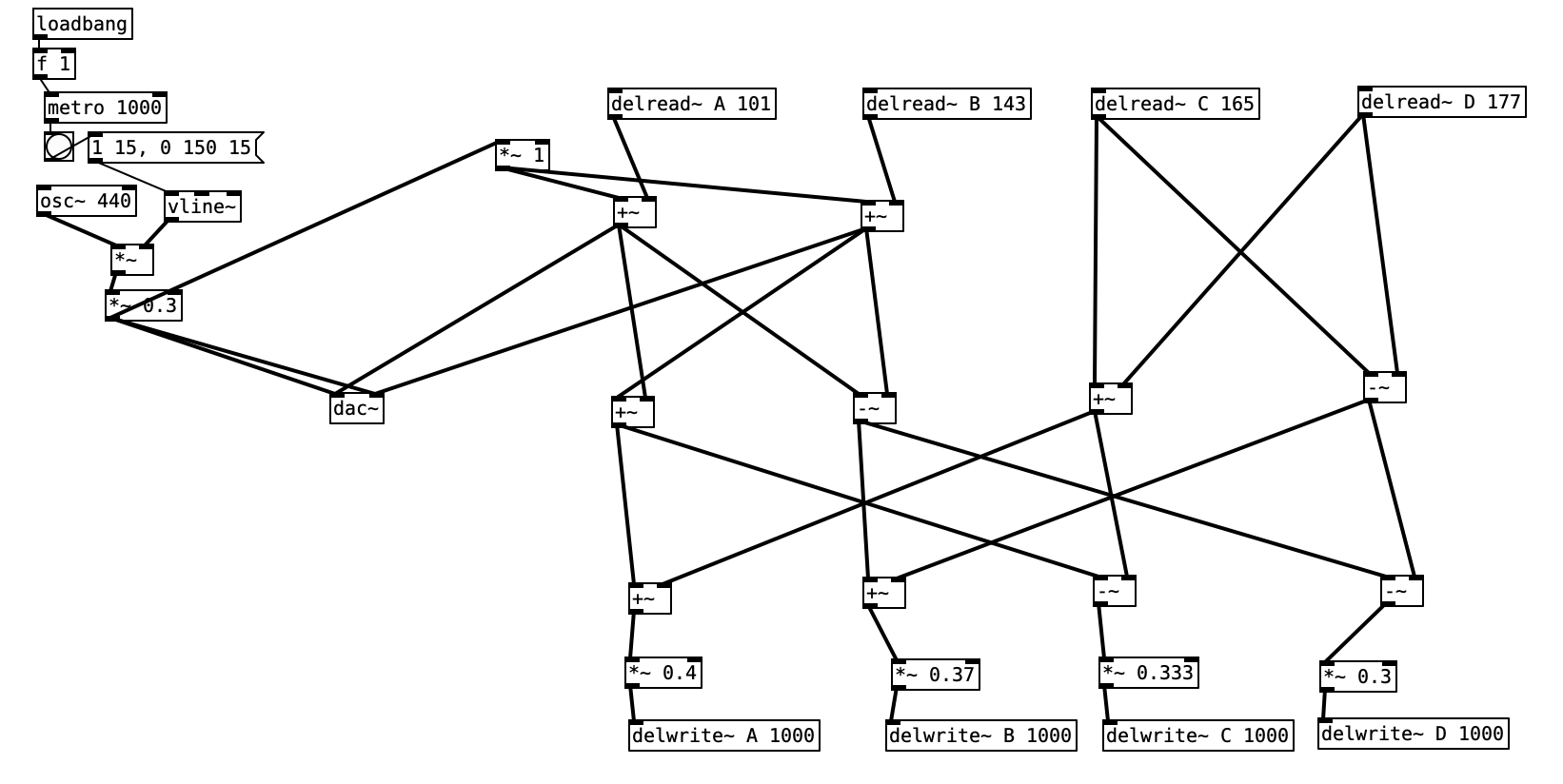
Reverberation is (more or less) lots of little echoes in a room or space that add up to smear out a sound.
-
We can simulate this with delays!
-
This one is borrowed from
G08.reverb.pd. -
There’s also
rev2~andrev3~included in Pd that have early reflections and other niceties.
There’s a completely different approach to reverb using convolution, but that’s another story.
Distortion
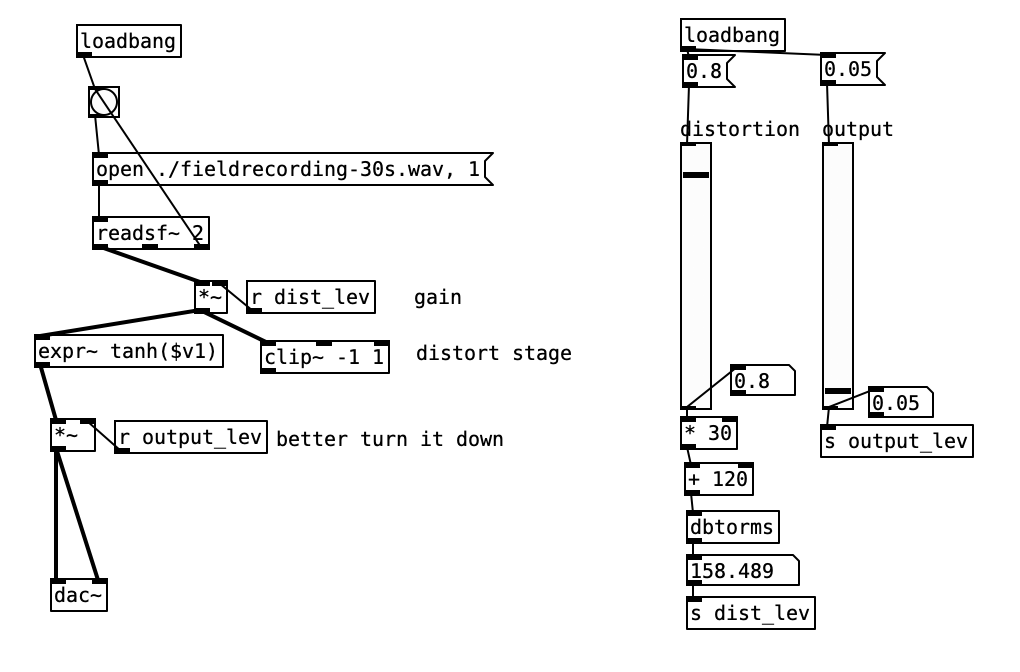
Distortion is when a signal is “clipped” resulting in undesirable extra sounds.
Are they really undesirable?
-
amplify signal—a lot! (e.g.,
*~ 150) -
clip! Either with
clip~(hard clipping) or thetanhfunction (soft clipping).
Remember to boost the input gain a LOT for sweet distorted goodness.
Compression
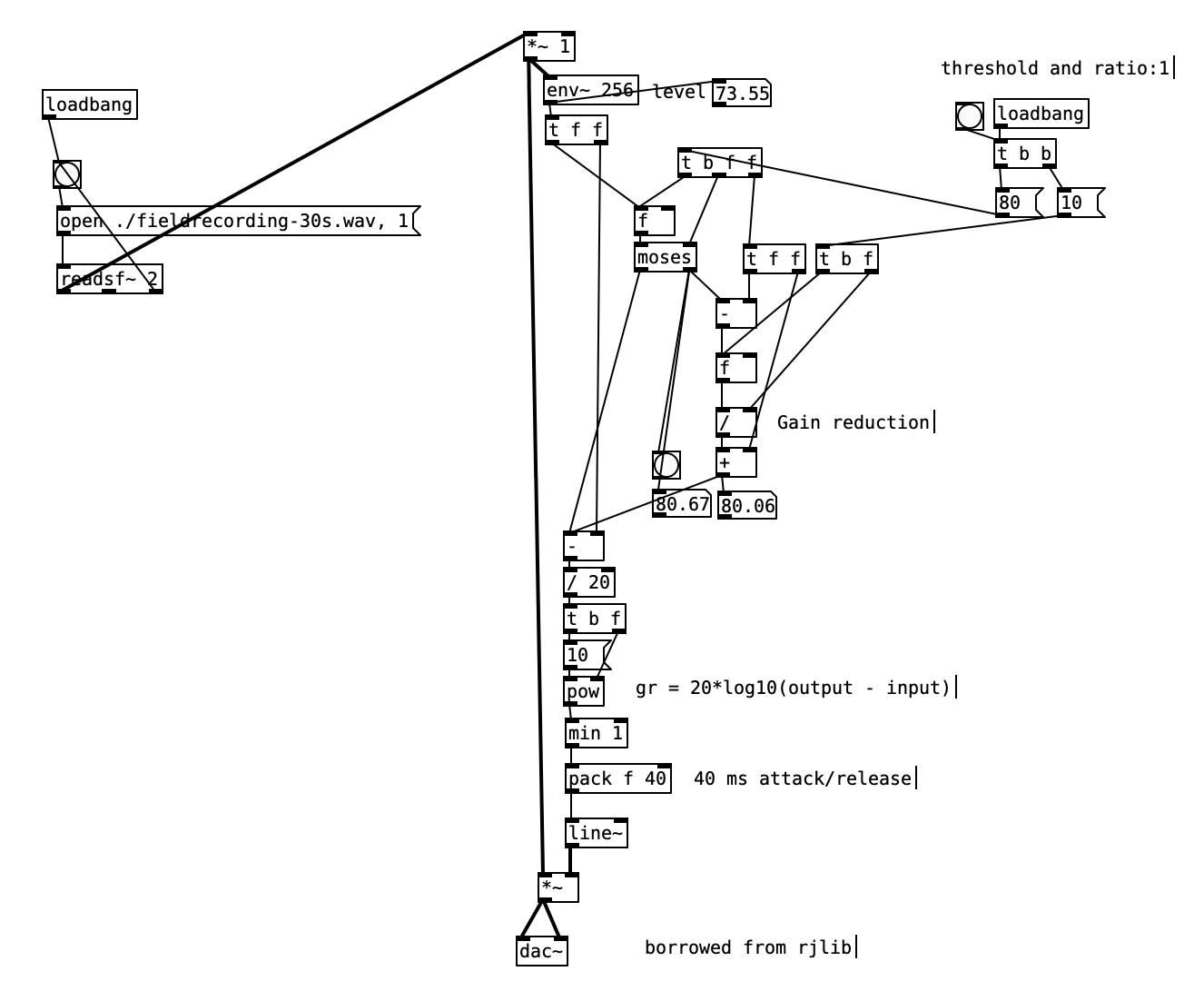
A compressor turns down the volume if a signal rises above a threshold.
- useful to mix sounds of different volumes
- or to help amplify a quieter sound without getting surprised by sudden increases in volume.
Filters
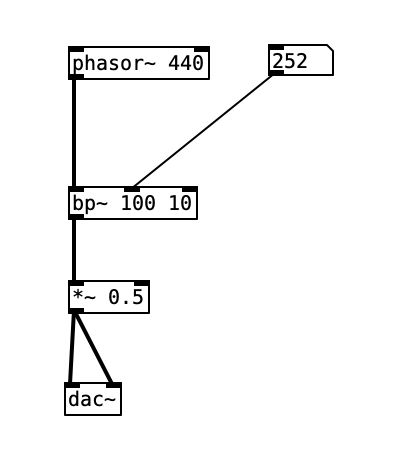
Filters “remove” parts of a sound that correspond to certain frequencies.
-
lop~: low-pass filter,hip~: high-pass filter,bp~: band-pass filter. -
vcf~is a low-pass filter designed to be dyanmically controlled (e.g., with an envelope) -
bob~is almost the same asvcf~but specifically modelled on filters in Moog analogue synths. -
and many more…
Lots of filters—Must be important. (read (a lot) more…)
Shaping a sound with filters
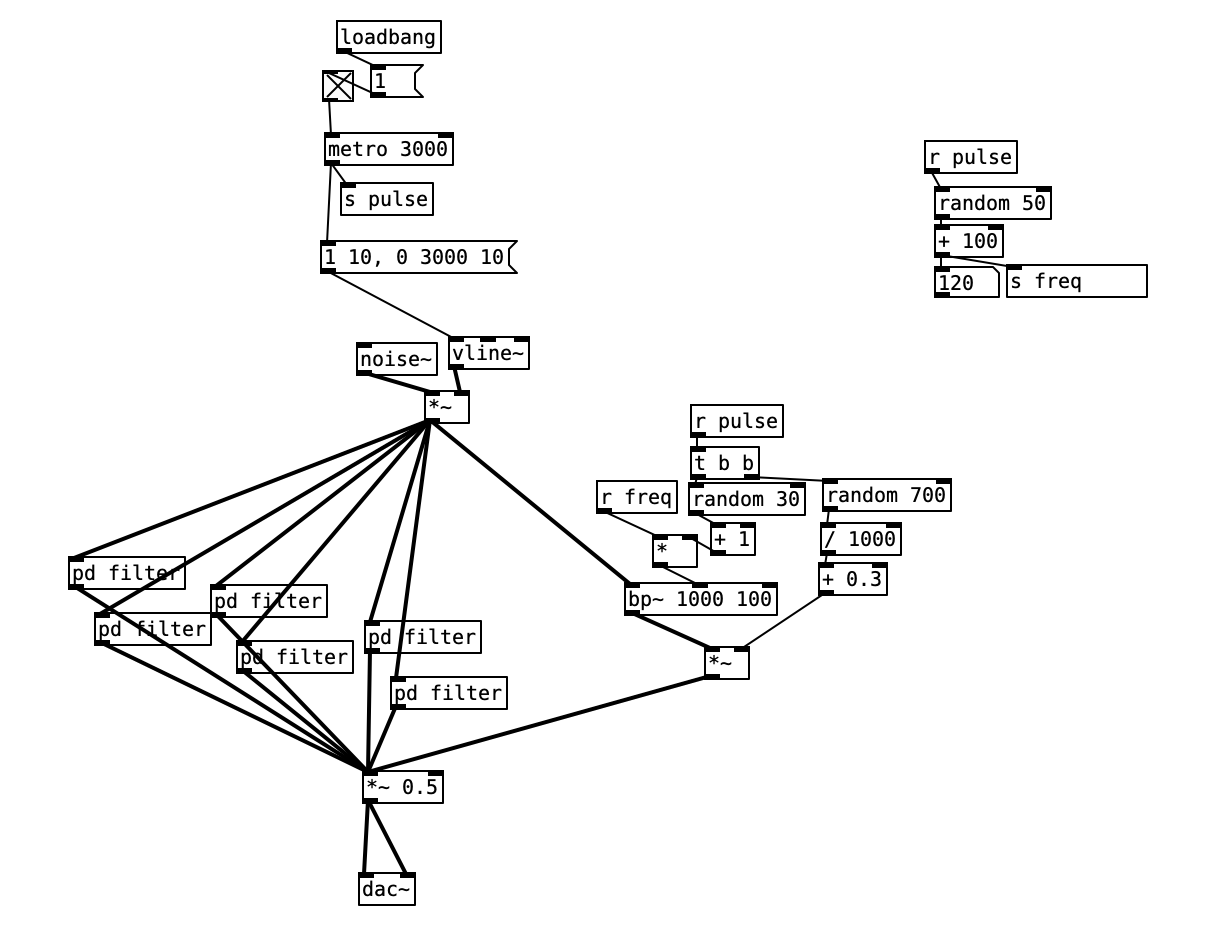
- Start with
noise~ - Add filters to remove lots of sound
- Profit!
Exercise:
Time to add some effects to your synthesiser. Here are some options:
-
create a delay unit with the parameters discussed.
-
add a
vcf~filter to a sawtooth oscillator. Use a second envelope to control the filter frequency. -
create a really long reverb and use it with very short synth sounds (use a short attack-release envelope)
-
create multiple effects in a signal chain and use GUI objects to control how much of each one is present in the output sound.